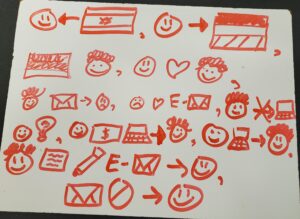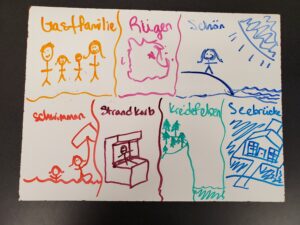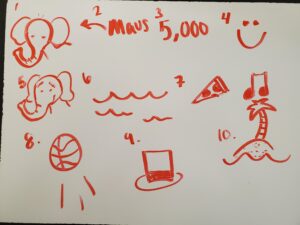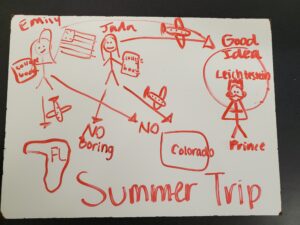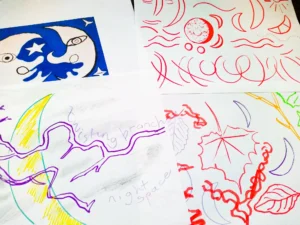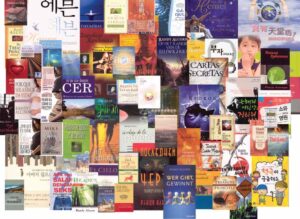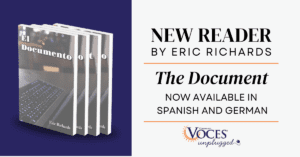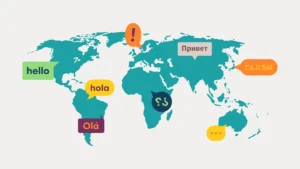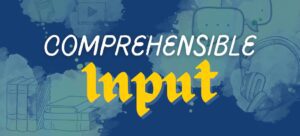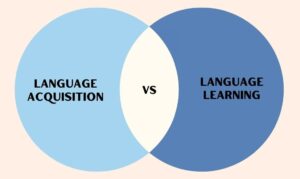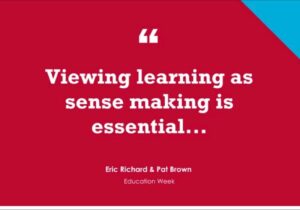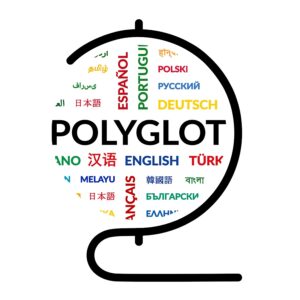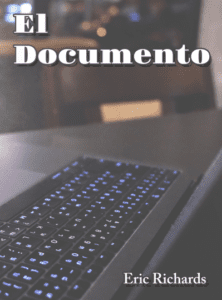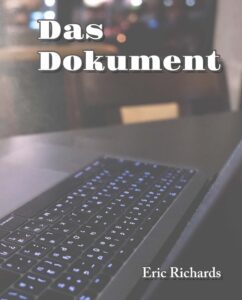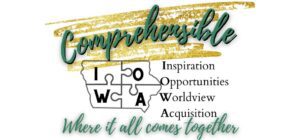Eric Richards Instructional Consulting, LLC
Note: Please read the following blog posts before this one: Keywords (and Pictures) This activity is a simple variation to “Keywords (and Pictures) & Read, Draw, and Discuss / Listen, Draw, and Discuss” . However, instead of using drawings during the activity, students use emojis. I know that this seems like a rather minute (and even perhaps inconsequential)…
Read MoreThis activity is similar to “Picture Talk”. If you are are not familiar with Picture Talk, you find out more here: How do I do a Picture Talk Picture Talk 101 This is most likely not the newest, most groundbreaking activity that you will come across, but nonetheless, I enjoy doing this activity with my…
Read MoreNote: Please read the following two blog posts before this one: This activity is a simple variation to “Read, Draw, and Discuss” and “Listen, Draw, and Discuss“. The short of it is, instead of using drawings during the activity, students use keywords (in the target language). A small variation is to have them use both…
Read MoreThis activity is an excellent way to personalize a text/story and give students ownership of it. In this activity, students are not only supported in their engagement with the language, but they also get the benefits of repetition of the vocabulary and structures. What is more, they even get the benefits of drawing, including memory…
Read MoreThis activity is similar to Read, Draw and Discuss, however it has a twist. You’ll notice that it is “Listen” and not “Read” in the title. It is an excellent way to scaffold support for listening comprehension with students. In this activity, students are not only supported in their engagement with listening and comprehending the…
Read MoreThe following post is courtesy of Keith Toda. He teaches Latin at Parkview High School, a public school in Lilburn, GA. He teaches with four other Latin teachers in one of the largest Latin programs in the nation (USA). I highly recommend that you bookmark his blog and come back to it. There is truly…
Read MoreA recently posted on an activity called “Read, Draw, and Discuss“. After incorporating this activity, I started incorporating whiteboards and drawing more often in my classes at all levels. (I will post more on how I incorporated them later. So, check back!) I originally did it, because my students enjoy it and are more engaged…
Read MoreAs language educators, we know that reading in the target language is crucial for language development (both in the L1 and L2). We also know that we have choices about what we choose to read in the classroom. This includes, level-appropriate readers, authentic texts, graphic novels, etc. With these choices also comes the discussion about…
Read MoreExciting news! My new Level 1 / A1 reader is now available at Voces Digital – both in Spanish and German! Check it out here: “El documento” / “Das Dokument” About The Document:Enrique’s encounter with his cousin Karla at a café takes an unexpected turn when he discovers a mysterious flash drive under the table. Believing it…
Read MoreI recently had the honor of reviewing Lynne Breen’s latest book – Freedom at Niagara – before it was published. It is truly a fascinating book and you’ll undoubtedly walk away from this book having learned something new. Here is the review: “Lynne Breen delivers an important work that details the often overlooked role that…
Read MoreThe following post is courtesy of Keith Toda. He teaches Latin at Parkview High School, a public school in Lilburn, GA. He teaches with four other Latin teachers in one of the largest Latin programs in the nation (USA). I highly recommend that you bookmark his blog and come back to it. There is truly…
Read MorePat Brown and I recently had our article “Exploring Before Explaining in World Languages” published in Edutopia – George Lucas Educational Foundation. https://www.edutopia.org/article/using-patterns-teach-world-languages Our article introduces the concept of “explore-before-explain” teaching in world language classrooms, aiming to redefine the roles of teachers and students, enhance student agency, and address the complex standards set by the…
Read MoreWe will wrap up our series on “SLA-Speak” by looking at “Comprehensible Input”. Note: This is the fifth and (possibly) final post in the series. What is “Comprehensible Input”? Comprehensible Input (CI) is a concept in language learning that refers to language input. The language input received by the language learner is just challenging enough…
Read MoreContinuing our series on “SLA-Speak”, we’ll now look at the “Affective Filter”. Note: This is the fourth post in the series. What is the “Affective filter”? The Affective Filter is a concept in language learning. It is like a mental gate that can either open or close while you’re learning a language. In other words,…
Read MoreContinuing our series on “SLA-Speak”, we’ll now look at “Fluency” vs. “Accuracy”. Note: This is the third post in the series. Fluency and accuracy are two important aspects of language proficiency. Let’s take a look at the difference between them: Fluency: Accuracy: Key Differences: Briefly stated, both fluency and accuracy are essential for effective communication…
Read MoreContinuing our series on “SLA-Speak”, we’ll now look at “Acquisition vs. Learning”. Note: This is the second post in the series. Acquisition and Learning are two distinct processes involved in Second Language Acquisition (SLA), as proposed by linguist Stephen Krashen. Let’s take a closer look at the differences between these two terms: Acquisition: Learning: Key…
Read MoreAs a language educator, I find myself talking to others about SLA (Second Language Acquisition). I also find that I use terms, definitions, and acronyms that are unfamiliar to the other person, or perhaps the other person has a different idea what the term means. So, I thought it would be a good time to…
Read MoreHere is the link to my presentation: CI Summit: Writing Strategies for the ADI Classroom. Part 1 Part 2 Part 3 I hope it fills a need and you find it helpful! If you have any questions, please contact me directly at: contact@eric-richards.com Thank you! Mach’s gut!
Read MoreHere is the link to my presentation: VOCES: Focusing on Short Stories in Our Story Part 1 Part 2 I hope it fills a need and you find it helpful! If you have any questions, please contact me directly at: contact@eric-richards.com Thank you! Mach’s gut!
Read MoreDr. Pat Brown and I continue to collaborate on ideas to how to improve education and student learning. I always enjoy working with Pat, because we bring together overlaps from the science and world language classrooms. We always look at how we can use students’ ideas about language, science, discourse, and communication to develop conceptual…
Read MoreWhat is Texas German? Any guesses? Is it simply Germans, who live in Texas? Or is people who speak German with a bit of a Texas accent? No! There is more to it than that. Texas German is more than just a language. It is own culture and enjoys a rich history. The Texas German…
Read MoreHere is the link to my presentation: Entry Points into Culture I hope it fills a need and you find it helpful! If you have any questions, please contact me directly at: contact@eric-richards.com Thank you! Mach’s gut!
Read MoreSince I was young, I was always fascinated by people that could fluently speak multiple languages. I constantly asked myself, “How can they do that?” Then I thought, “That person must be super smart! I wish I were that smart.” As I grew, I continued to find myself interested in languages. I was always interested…
Read MoreI am excited to share that my latest reader is now out in Spanish! (Note: There are excerpts from the Spanish version of book at the end of the post.) I previously published a German reader, entitled “Das Dokument”, and I’m excited to announce that it is now available in Spanish! I can’t wait to…
Read MoreI recently came across a couple of articles that deal with language and the brain. I found them quite interesting and thought I would share. They deal with how our L1 (first language / mother tongue) influences our brain, its formation, and how we process different languages. Scientist are using the information to better help…
Read MoreI wanted to share the news. My latest reader Das Dokument has been published! (Note: There are excerpts from the book at the end of the post.) I’m excited to get this in the hands of German language learners. It is a chapter book with 100 unique words that is written for Level 1/A1 language…
Read MoreI wanted to let you know that Comprehensible Iowa #CIIA23 is fast approaching. It is Friday, June 9th – Saturday, June10th in Gilbert, IA. (Just north of Ames, IA) This conference is excellent opportunity for world language educators. The presenters, which are coming in from 7 different states, are excellent. This will be a great…
Read MoreNote: There is a link to resources below. If there were only one thing that we could do with our students in the classroom, what should it be? Reading. Reading is unquestionably one of the most important things – if not the most important thing – that our students should do. I would even add…
Read MoreNote: There are links to resources below. As world language educators, we are tasked with not only making the target language accessible and comprehensible to our students, but also getting our students to engage in presentational, interpretive, and interpersonal modes of communication in the target language. As many world language teachers try to find a…
Read MoreCreated in 1832 by 16-year-old apprentice chef Franz Sacher at the court of Prince Metternich, Sachertorte is considered by many to be the reigning king of Austrian desserts. However, many believe this king should be usurped by the noble Apfelstrudel. You be the judge! I’ve included a link from austra.info to a recipe for Sachertorte. You…
Read More